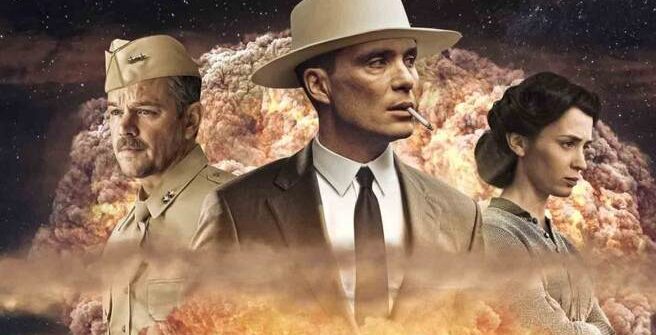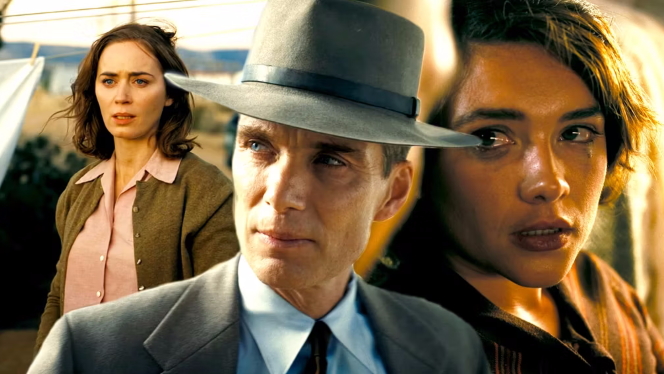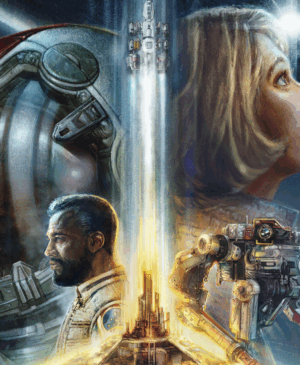MOVIE REVIEW – In his twelfth feature film, British-American director Christopher Nolan delves into the life of Julius Robert Oppenheimer, known as the father of the atomic bomb, across three distinct periods. The scientist, an entity of complex personality, is portrayed both as an idealist and an opportunist. The film is quintessentially “Nolan-esque” yet unconventional: the traditionally expected elements of science fiction, action, and time maneuvering are absent. However, the visual spectacle and careful arrangement of the three timelines are classic Nolan traits. Nonetheless, the director’s work is not exempt from a few imperfections.
Julius Robert Oppenheimer, born in 1904 and died in 1967, was a Jewish scion from an affluent family, affiliated with the American Communist Party, battled depression, yet was a distinguished chemist, a genius physicist, and a pioneer of quantum mechanics. Appointed as the scientific director of the Manhattan Project in 1943, the project was clandestinely developed in Los Alamos amidst an arms race against the Nazi regime. Known as the father of the atomic bomb, Oppenheimer changed his stance post-war regarding the validity of the thermonuclear (hydrogen) bomb, advocating for international regulation of such weapons. This stance made him the black sheep in the eyes of President Harry Truman, who was suspicious of his former communist sympathies, and soon the paranoia of the era’s witch hunt caught up with him, leading to a trial for espionage in 1954, where his fate was sealed in advance. Eventually recognized as a “loyal patriot”, he was nevertheless accused of grave errors and subsequently expelled from the Advisory Committee of the Atomic Energy Commission. Nolan focuses on this phase of his life, thus we see nothing of his childhood, and only a brief scene from his life after his rejection.
The director, amidst his film’s rather elliptical structure, examines whether scientists bear responsibility based on their conscience and people’s judgement for how politicians use their inventions. He devotes three hours to this question, filled with numerous dialogues and static scenes, where Oppenheimer and other significant characters are interrogated by various committees.
Interwoven timelines – like nested Matryoshka dolls
If I were to compare it to a similar film, Oliver Stone’s JFK comes to mind, wherein a multitude of characters and extensive dialogues unpack the investigation surrounding the Kennedy assassination. However, Stone, while reconstructing historical events, intriguing real characters, and a famous murder, never loses pace despite the wealth of dialogue, unlike in Oppenheimer, where we witness numerous static scenes from committee hearings, packed with relentless dialogues and the juxtaposition of the three periods, which are interestingly interwoven. These scenes are akin to Matryoshka dolls, nested within each other, and throughout the film, Nolan sequentially unearths these, thereby entangling the narrative. The largest and chronologically latest period – shown in black and white, for reasons unknown – depicts the hearing of the shoe and jeans tycoon Lewis Strauss (Robert Downey Jr.), a high-ranking official answering for his role in the charges against Robert Oppenheimer and his subsequent dismissal, played out a few years prior. It turns out that his role – due to ideological reasons (Strauss was a fiery conservative) and personal reasons (Oppenheimer publicly humiliated him) – was particularly detrimental to the atomic scientist.
The second layer of the Matryoshka dolls finds Oppenheimer answering before another committee organized by Lewis in 1954. This is a poignant moment, where the scientist is genuinely unable to defend himself, and amongst the testimonies, we hear not only loyal friends but also “traitorous” statements. A prime example is Edward Teller of Hungarian origin, who Oppenheimer had included in the Los Alamos team, and who was a lone warrior even then. He became the father of the future hydrogen bomb, which was five times more powerful than the atomic bomb. Edward Teller also inspired Stanley Kubrick’s film, “Dr. Strangelove.”
The third “doll” (or timeline) essentially contains the reconstruction of the Los Alamos adventure in a ghost town in the New Mexico desert. This phase recalls Oppenheimer’s coordinating role, his relations with his environment, such as his wife, Kitty (Emily Blunt), who regularly criticizes his weak character, or with army General Leslie Richard Groves (Matt Damon), who despite his earlier political commitment, trusts him and leads the mission. Even more importantly, as we approach the fatal hours of the bombs dropped on Hiroshima and Nagasaki, we get a profound character study of the fatefully extroverted and eternally lonely Robert Oppenheimer, masterfully portrayed once again by Cillian Murphy.
Cillian Murphy shines as Oppenheimer
Choosing Cillian Murphy as Oppenheimer is a brilliant decision. The actor, who has worked with Nolan in the past, offers a subtle and nuanced performance, capturing both the intelligence and vulnerability of his character. In a film with a lot of dialogue and little action, the weight of Murphy’s performance is essential to maintaining the viewer’s attention.
The other actors are also impressive, especially Robert Downey Jr., who brings a cool, calculating intensity to his role as Lewis Strauss, and Matt Damon, whose portrayal of General Leslie Richard Groves is both authoritative and humanizing. Emily Blunt also stands out as Kitty, Oppenheimer’s wife, bringing a dose of realism and sensitivity to a character that could easily have become a simple cliché.
Visually, “Oppenheimer” is a masterpiece. Hoyte van Hoytema, a regular collaborator of Nolan’s, creates stunning images that bring the story to life. The use of black and white for the last timeline is a bold aesthetic choice, but effective, reinforcing the feeling of isolation and tragedy surrounding Oppenheimer.
However, the film is not without flaws. As mentioned earlier, the pace is sometimes slow, and some may find the blending of the three timelines confusing. Additionally, the script, although rich in historical and scientific details, sometimes lacks clarity, especially when it comes to explaining the complexities of the Manhattan Project and the science behind the atomic bomb.
Oppenheimer: The Typical Nolan Hero
In other words, even after watching Christopher Nolan’s film, we won’t exactly know who Robert Oppenheimer really was. However, this is not a problem, as it maintains the character’s mystique. He was a complex man, simultaneously an idealist and opportunist, riddled with contradictions and weaknesses, suffering from guilt for his own terrible invention, and torn by the belief that he saved lives by stopping the war. Yet, it seems that Nolan, the artist, is more interested in Oppenheimer the scientist than Oppenheimer the historical figure.
In this sense, Oppenheimer fully takes his place in Nolan’s gallery of heroes. He wields a power that is made vulnerable by an unspeakable secret, unsure of himself in a complex and opaque world. He is not free from deceit, seeking light and goodness on dark paths, even when they are in direct contradiction to him: Batman isn’t as far away as we might think.
On the other hand, Nolan himself, perhaps the last great creator of Hollywood, can increasingly view himself as a high-level speculative researcher as his oeuvre enriches, capable of breaking down narrative structures at the atomic level and examining their components.
Nolan’s works are known to take place on a complicated timeline and are also structurally complex, while never lacking humanism and emotional reality. “Memento,” “Inception,” “Interstellar,” and now “Oppenheimer” are all excellent examples of this complexity and depth.
From the unforgettable backwards narrative of “Memento,” through the dream-within-a-dream structure of “Inception,” the complexity generated by time dilation and relative timing in “Interstellar,” and now the use of three nested timelines in “Oppenheimer,” Nolan continuously explores the complex interconnections of time, memory, reality, and perception. However, he never ignores the inner experiences and feelings of people, so his films always directly affect the viewers.
Nolan’s creations resonate with ancient myths and personal stories alike. His stories often deal with self-sacrifice, guilt, regret, recurring memories, and the burden of time, all integral parts of most people’s life experiences. His heroes are complex, often feeling guilt or battling personal demons as they strive to achieve their goals and access hidden truths.
“Oppenheimer” further solidifies Nolan’s status as one of the most innovative and daring creators in Hollywood film art. As he breaks down and reconstructs the narrative at an “atomic level,” the creator opens up new dimensions for the viewer and allows us to understand his story and characters from different perspectives. The film is therefore not just a biographical piece about Oppenheimer’s life, but also a profound meditation on the complex themes of human existence, guilt, responsibility, and remorse.
-BadSector-
Oppenheimer
Direction - 7.4
Actors - 8.2
Story - 7.8
Visuals - 7.5
Ambience - 7.8
7.7
GOOD
"Oppenheimer" is a complex and ambitious work that highlights a fascinating and controversial historical figure. Despite its flaws, the film is an impressive demonstration of Christopher Nolan's talent as a director and storyteller. For fans of Nolan and those interested in the history of science and the Cold War, "Oppenheimer" is a cinematic experience not to be missed."

















Leave a Reply